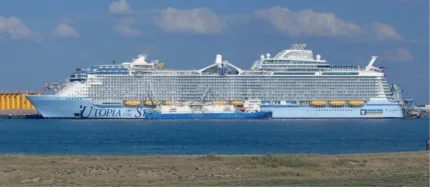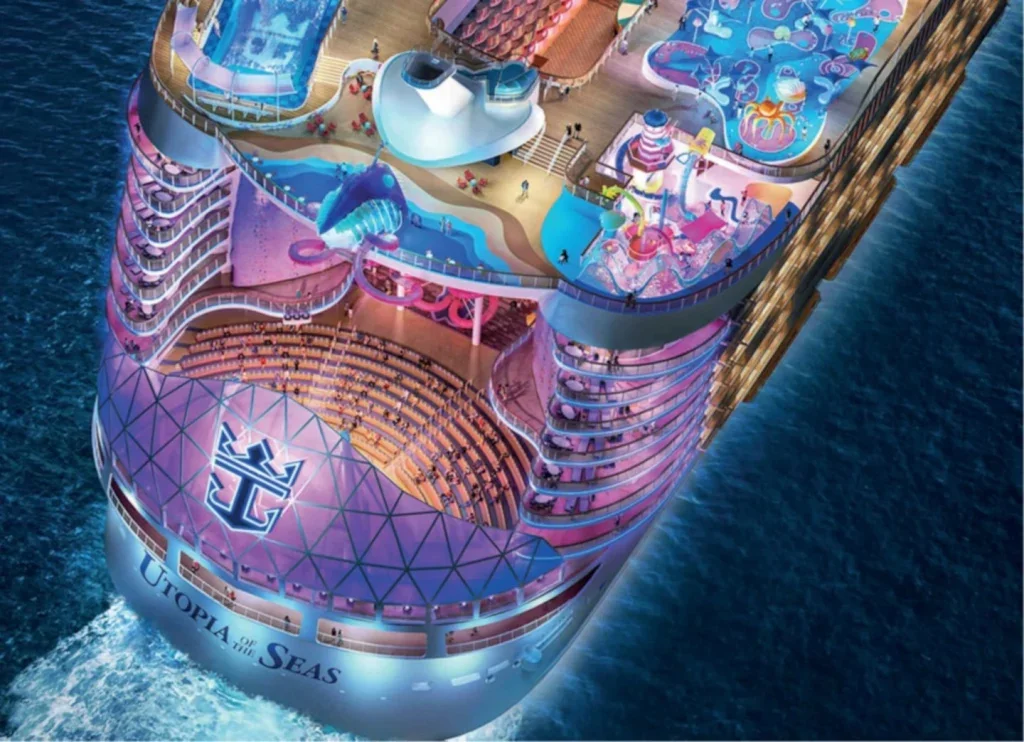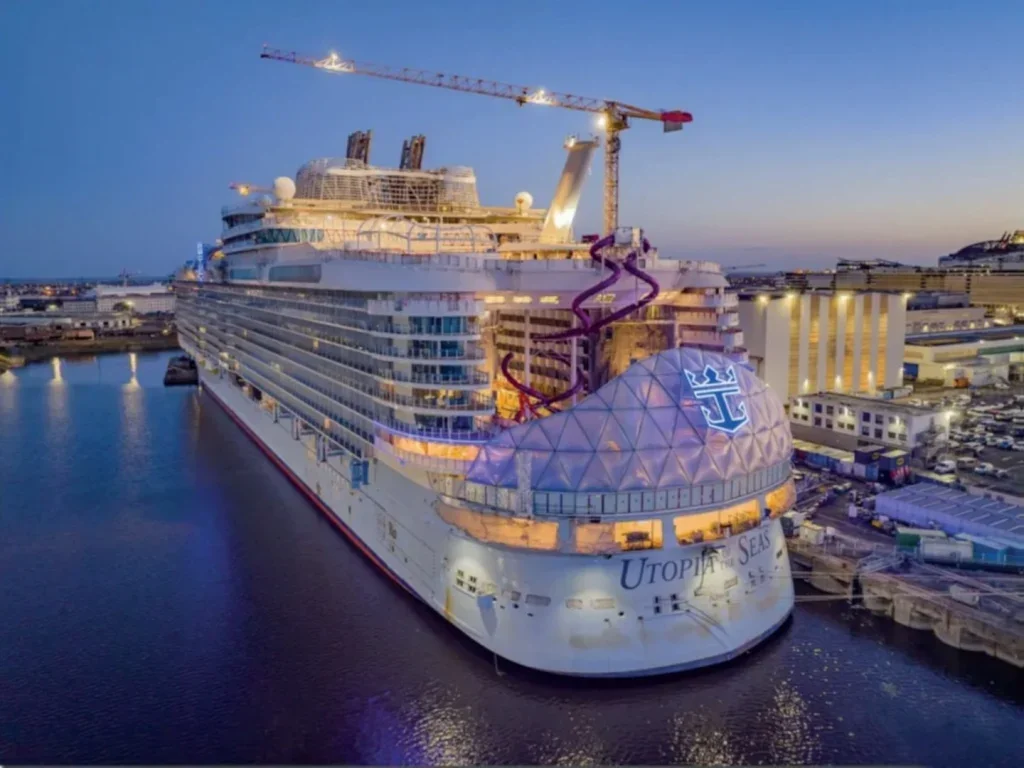
For longstanding cruise industry-watchers, it seems almost unbelievable that Royal Caribbean’s Oasis class can already boast six members. When Oasis of the Seas launched back in 2009, the sector had never seen the like, in both scale of shipbuilding and extent of coverage. Headlines obsessed over how a cruise ship carrying more than 6,000 paying passengers was even feasible.
Described in marketing brochures at the time as “a floating city”, many critics questioned the longterm viability of such an undertaking. Did the appetite for this sort of cruise experience exist? Were we looking at ambition or folly? The world’s largest ever cruise ship was unable to even dock in European ports, requiring custom-made facilities that could handle its bulk and passenger numbers. “In years to come,” concluded The Observer’s review upon launch, “Oasis of the Seas – commissioned before the credit crunch at a cost of $1.4bn and completed after it – may be seen as something of a symbol of the end of an American empire based on vast consumption.”
Defying the critics
That critic, and many others, underestimated how global appetite for such size and scale of ambition would evolve. Sister ship Allure arrived a year later, followed by Harmony (2016), Symphony (2018), and Wonder (2022), each new arrival larger in gross tonnage than the last. Entering service in July 2024, Utopia of the Seas has continued this trend. What it also reflects is an ongoing habit among industry watchers to focus first and foremost on size, rather than finesse – a trend one can trace all the way back to those first Oasis reviews 15 years ago.
What such takes tend to ignore is that, first and foremost, these ships are incredible feats of shipbuilding and design. Like its three direct predecessors, Utopia was constructed at Chantiers de l’Atlantique. Yes, it spans 1,188ft in length and has a gross tonnage of 236,680t, but the vessel actually belies its immense size. Boasting a streamlined, aerodynamic profile, the exterior is engineered to optimise hydrodynamics, enhancing both speed and fuel efficiency and high-strength steel forms the hull, with prefabricated sections assembled to drive durability and quality.
Indeed, scale drove creativity across the design process. A modular construction approach allowed for the simultaneous building of large sections in different locations, later transported to the final assembly site. This method significantly reduced construction time while maintaining quality control. The ship’s superstructure, incorporating lightweight materials such as aluminium, is intended to enhance buoyancy and stability.
Chantiers de l’Atlantique employed advanced digital tools and techniques throughout the construction process. 3D modelling and simulation software were crucial during the design and engineering phases, allowing precise planning and optimisation. Virtual reality technology enabled designers and engineers to visualise and refine the ship’s layout and systems in a virtual environment before physical construction began.

A grand feat of engineering
The shipyard also implemented lean manufacturing principles to streamline production and reduce waste. Automated welding robots, laser cutting machines, and other high-tech equipment ensured precision and efficiency in assembling the ship’s components.
According to Royal Caribbean Group president and chief executive Jason Liberty, speaking at the vessel’s naming ceremony, Utopia contains “enough cable to wrap around the planet twice”, and took more than 10 million working hours to finish.
The propulsion system is a notable feat of marine engineering. This ship is the first member of the Oasis class to be powered by a hybrid propulsion system combining traditional diesel engines with liquefied natural gas (LNG) technology. This greatly reduces emissions, complying with and exceeding the International Maritime Organization’s stringent sulphur oxide emission regulations from launch. Such hybrid capabilities mark a huge step for demonstrating the longer-term feasibility of large-scale cruising as the industry begins to pivot towards net zero.
“It is important to introduce new technology on our ships to continue advancing our net-zero ambitions while providing an exception experience for our guests,” explains Royal Caribbean Group technical manager Laurent Tessier.
Utopia is the first ship to be equipped with six Wärtsilä 46TS-DF engines, providing a total output of 100 MW. These engines use a common rail fuel injection system to optimise fuel consumption and reduce emissions. ABB’s Azipod propulsion units improve manoeuvrability and efficiency. Mounted externally on the ship’s hull, allowing for 360-degree rotation. This configuration eliminates the need for traditional rudders and stern thrusters, reducing hydrodynamic drag and enhancing fuel efficiency.
Supporting the propulsion system is an advanced energy management system (EMS), which monitors and optimises energy use throughout the vessel. This system integrates data from various sensors and systems to provide real-time insights and predictive maintenance capabilities, ensuring peak operational efficiency.

Utopia is equipped with a sophisticated integrated automation system (IAS) that monitors and controls all aspects of shipboard operations. This system integrates navigation, propulsion, power management and safety systems into a unified platform, enabling seamless control and real-time decision-making.
The IAS utilises advanced algorithms and artificial intelligence (AI) to predict and respond to changing conditions. For instance, the system can automatically adjust engine parameters to optimise fuel consumption based on real-time weather data and sea conditions. Additionally, it enhances safety by continuously monitoring critical systems and alerting the crew to potential issues.
Sustainable entertainment
In an era where sustainability is paramount, Utopia of the Seas has sought to set new standards for environmentally responsible cruising. The aforementioned use of LNG as a primary fuel source promises to reduce sulphur oxide emissions by 99%, nitrogen oxide emissions by 85% and carbon dioxide emissions by up to 20%. The vessel is also equipped with an advanced wastewater treatment system that exceeds IMO standards. This system employs membrane bioreactor technology to treat wastewater to near-drinking water quality before discharging it into the sea. Additionally, the ship has a comprehensive waste management system, including recycling facilities and an onboard incinerator for reducing waste volume.
Energy-efficient lighting, HVAC systems and smart energy management practices further enhance the ship’s sustainability profile. Integrating solar panels and energy recovery systems allows Utopia to harness renewable energy, reducing its reliance on fossil fuels.
Utopia also shares many design elements and technological advancements with other vessels in the Oasis class, particularly its sister ship, Wonder of the Seas. However, several differences set Utopia apart. For a start, it is marginally larger in gross tonnage compared to Wonder, although the difference in physical dimensions is minimal. Guests are unlikely to notice the difference of LNG propulsion, but there are changes that will be remarked upon.
While both ships boast an extensive array of amenities, including multiple dining options, pools, casinos and entertainment venues, Utopia’s design includes new features such as the railway dining car-themed restaurant and additional culinary and recreational options. Most notably, Utopia has been optimised for shorter cruise itineraries, specifically three-night weekend and four-night weekday trips, marking a departure from the longer itineraries typically associated with larger ships.
Boasting a passenger capacity of over 6,700, the ship features 21 restaurants, five pools, two casinos and an ice skating rink, spread over 18 decks and eight distinct “neighbourhoods”. Also included is a railway dining car-themed restaurant, reflecting its approach to onboard amenities.
“With the delivery of Utopia of the Seas, we have the keys to the ultimate weekend,” claims Michael Bayley, president and CEO, Royal Caribbean International. “This is the short vacation that packs every way to make amazing memories in a three-night weekend or four-night weekday getaway. Vacationers want every minute to be a minute well spent.”
Indeed, Royal Caribbean is positioning Utopia of the Seas as the “world’s biggest weekend”, aiming to attract first-time cruisers and those seeking brief but immersive experiences.
“The volume of new-to-cruise is significantly higher on short product than it is on longer for very logical reasons,” Bayley explains. “It’s just a much easier product to purchase. It’s only a few days. It’s less investment of time for new-to-cruise. And we found that when you get the product right, you can stimulate it a large amount of demand.”
Early reports since the ship embarked upon its maiden itinerary in July suggest Royal Caribbean may indeed have got it right. Utopia leans on the success of its predecessors, but in terms of performance, design, experience and purpose, it’s also a character all of its own. A lot has happened in the 15 years since the Oasis-class first launched, but, in many ways, Utopia feels like the culmination of all those experiences and lessons.






